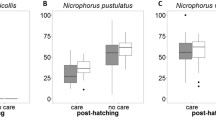Summary
If no female is present, male burying beetles Nicrophorus vespilloides (Coleoptera: Silphidae) co-operate in the burial of a corpse. Once a female has arrived, the males fight with one another. The defeated male stays near the corpse and to copulate with the female. Laboratory experiments using sterilised males showed that the defeated male was able sometimes to father some of the offspring raised on the corpse. Male N. vespilloides almost always participate in defence and feeding of the brood. This is not affected by the size of the male. Males quickly leave or are driven from 5 g corpses. Males feed the larvae as often as females do, and larvae raised by males alone are not significantly different in weight from larvae raised by females alone or by both parents. Males which cared for a succession of broods in the laboratory did not differ significantly in median lifespan from males which were removed from their corpses after eggs had been laid. Non-caring males weighed significantly more than caring males over a sequence of corpses, but the caring males did not differ significantly in weight from non-breeding controls.
Similar content being viewed by others
References
Bartlett J (1987a) The behavioural ecology of the burying beetle Nicrophorus vespilloides (Coleoptera: Silphidae). PhD thesis, University of Edinburgh
Bartlett J (1987b) Filial cannibalism in burying beetles. Behav Ecol Sociobiol 21:179–184
Bateman AJ (1948) Intra-sexual selection in Drosophila. Heredity 2:349–368
Boggs CL, Gilbert LE (1979) Male contribution to egg production in butterflies: evidence for transfer of nutrients at mating. Science 206:83–84
Davies NB (1985) Co-operation and conflict among dunnocks, Prunella modularis, in a variable mating system. Anim Behav 33:628–648
Dawkins R, Carlisle TR (1976) Parental investment and mate desertion: a fallacy. Nature 262:131–133
Easton C (1979) The biology of burying beetles. PhD thesis, University of Glasgow
Eickwort GC (1981) Presocial insects. In: Hermann HR (ed) Social insects, vol. 2. Academic Press, New York
Fabre JH (1919) The Glow-worm and other Beetles (tr AT de Mattos). Hodders & Stoughton, London
Gibson RM, Jewell PA (1982) Semen quality, female choice and multiple mating in domestic sheep: a test of Trivers' sexual competence hypothesis. Behaviour 80:9–31
Gowaty PA (1983) Male parental care and apparent monogamy among eastern bluebirds (Sialis sialis). Am Nat 121:149–157
Halffter G, Anduaga S, Huerta C (1983) Nidification de Nicrophorus. Bull Soc Entomol France 88:648–666
Hinton HE (1981) Biology of insect eggs. Pergamon Press, London
Holmes HB (1974) Patterns of sperm competition in Nasonia vitripennis. Can J Genet Cytol 16:789–795
Howard RD (1978) The evolution of mating strategies in bullfrogs, Rana catesbeiana. Evolution 32:850–871
Martin K, Cooke F (1987) Bi-parental care in willow ptarmigan: a luxury? Anim Behav 35:369–379
Martin K, Cooch FG, Rockwell RF, Cooke F (1985) Reproductive performance in lesser snow geese: are two parents essential? Behav Ecol Sociobiol 17:257–263
Maynard Smith J (1977) Parental investment: a prospective analysis. Anim Behav 25:1–9
Neumann KW (1943) Die Lebengeschichte der Kafermilbe Poecilochirus necrophori nebst Beschreibung aller Entwicklungsstuffen. Zool Anz 142:1–21
Parker GA (1970) Sperm competition and its evolutionary effect on copula duration in the fly Scatophaga stercoraria. J Ins Physiol 16:1301–1328
Pukowski E (1933) Okologische Untersuchungen an Necrophorus F. Z Morphol Oekol Tiere 27:518–586
Ralston JS (1977) Egg guarding by male assassin bugs of the genus Zelus. Psyche 87:103–107
Smith RL (1980) Evolution of exclusive postcopulatory paternal care in the insects. F1 Entomol 63:65–78
Springett BP (1967) The biology of Necrophorus and the mortality of terns (Sterna): an ecological study. PhD thesis, University of Durham
Tallamy DW (1984) Insect Parental Care. Bioscience 34:20–24
Thornhill R (1979) Male and female sexual selection and the evolution of mating strategies in insects. In: Blum MS, Blum NA (eds) Sexual selection and reproductive competition in insects. Academic Press, New York
Trivers RL (1972) Parental investment and sexual selection. In: Campbell B (ed) Sexual selection and the descent of man. Aldine, Chicago
Walker WF (1980) Sperm utilisation strategies in nonsocial insects. Am Nat 115:780–799
Wilson DS, Fudge J (1984) Burying beetles: intraspecific interactions and reproductive success in the field. Ecol Ent 9:195–203
Author information
Authors and Affiliations
Rights and permissions
About this article
Cite this article
Bartlett, J. Male mating success and paternal care in Nicrophorus vespilloides (Coleoptera: Silphidae). Behav Ecol Sociobiol 23, 297–303 (1988). https://doi.org/10.1007/BF00300576
Received:
Accepted:
Issue Date:
DOI: https://doi.org/10.1007/BF00300576




